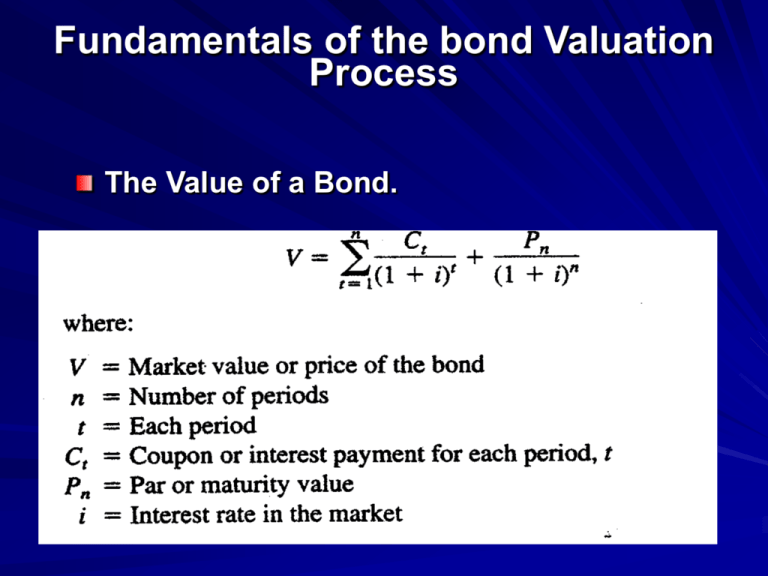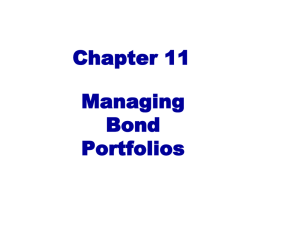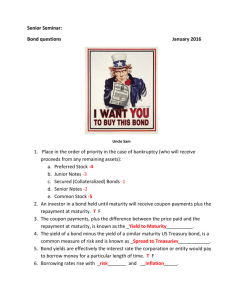
Fundamentals of the bond Valuation
Process
The Value of a Bond.
Computing Bond Yields
Yield Measure
Purpose
Nominal Yield
Measures the coupon rate
Current yield
Measures current income rate
Promised yield to
maturity
Promised yield to
call
Measures expected rate of return for bond held
to maturity
Measures expected rate of return for bond held
to first call date
Measures expected rate of return for a bond
likely to be sold prior to maturity. It considers
specified reinvestment assumptions and an
estimated sales price. It can also measure the
actual rate of return on a bond during some past
period of time.
Realized (horizon)
yield
Rates of Return
Approximate Promised Yield
APY = C + (Par – Market Price)/ NMaruity
.60 ( Market Price) + .4 (Par)
Yield to Call:
AYC = C + (Call Price – Market Price)/ NCall
.60 ( Market Price) + .4 (Call Price)
Approximate Realized Yield
ARY = C + (Realized Price – Market Price)/ NRealize
.60 ( Market Price) + .4 (Realize Price)
Corporate Bond Quotes
Cur
Bonds
Yld Vol Close
ATT 81/8 22 7.7 52 1053/8
Net
Chg
+ 1/4
52 of these bonds traded that day
Issued by AT&T
8.125% coupon rate; matures in 2022
Current yield = coupon/market price = 7.7%
The closing price was 105 3/8% of par which was up 1/4
from the prior day
Term Structure of Interest Rates
The relationship between maturity and
interest rates. It is also known as the Yield
Curve.
Expectations Hypothesis suggests that the
long-term rate is an average of the
expectations of the future short-term rates
over the applicable time horizon.
Reinforced by borrower/lender strategies.
Figure 12-1 Term Structure of Interest
Rates
Yield
Yield
Normal
a
b
Maturity
Maturity
Yield
Yield
c
Maturity
d Maturity
The Movement of Interest Rates
(cont.)
Liquidity Preference Theory states that the
shape of the yield curve is upward sloping.
Investors will pay a higher price for short-term
securities because they are more easily turned
into cash without the risk of large price changes.
Investors demand higher returns from longerterm securities.
The Movement of Interest Rates
(cont.)
Market Segmentation Theory focuses on
the demand side of the market.
– Banks tend to prefer Short Term liquid
securities to match the nature of their
deposits.
– Life insurance companies invest in Long-Term
bonds to match their Long-Term obligations.
Yield to
Maturity
Bond Value table
Coupon Rate 12 percent
Number of Years
10
20
30
8%
127.18%
139.59%
145.25%
10
112.46
117.16
118.93
12
100.00
100.00
100.00
14
89.41
86.55
85.96
Source: Reprinted by permission from the Thorndike Encyclopedia of Banking and financial tables, 1981. Copyright
©1981, Warren, Gorham and Lamont Inc. 210 South Street, boston MA. All rights reserved.
Investment Strategy: InterestRate Considerations
Bond Pricing Rules
– 1. Bond prices and interest rates are
inversely related.
– 2. Prices of long-term bonds are more
sensitive to a change in yields to maturity
than short-term bonds.
– 3. Bond price sensitivity increases at a
decreasing rate as maturity increases.
Investment Strategy: Interest-Rate
Considerations (cont.)
– 4. Bond prices are more sensitive to a decline in
market YTM than to a rise in YTM.
– 5. Prices of low-coupon bonds are more sensitive to
a change in YTM than high coupon bonds.
– 6. Bond prices are more sensitive when YTM is low
than when YTM is high.
– 7. Margin trading magnifies profits and losses of
bond investments by a factor of 1/(margin
requirement).
What Determines the
Price Volatility for Bonds
Five observed behaviors
1. Bond prices move inversely to bond yields (interest rates)
2. For a given change in yields, longer maturity bonds post
larger price changes, thus bond price volatility is directly
related to maturity
3. Price volatility increases at a diminishing rate as term to
maturity increases
4. Price movements resulting from equal absolute increases or
decreases in yield are not symmetrical
5. Higher coupon issues show smaller percentage price
fluctuation for a given change in yield, thus bond price
volatility is inversely related to coupon
What Determines the
Price Volatility for Bonds
The maturity effect
The coupon effect
The yield level effect
Some trading strategies
The Duration Measure
Since price volatility of a bond varies
inversely with its coupon and directly with
its term to maturity, it is necessary to
determine the best combination of these
two variables to achieve your objective
A composite measure considering both
coupon and maturity would be beneficial
The Duration Measure
n
Ct (t )
t
t 1 (1 i )
D n
Ct
t
t 1 (1 i )
n
t PV (C )
t
t 1
price
Developed by Frederick R. Macaulay, 1938
Where:
t = time period in which the coupon or principal payment occurs
Ct = interest or principal payment that occurs in period t
i = yield to maturity on the bond
Characteristics of Duration
Duration of a bond with coupons is always less than
its term to maturity because duration gives weight to
these interim payments
– A zero-coupon bond’s duration equals its
maturity
There is an inverse relation between duration and
coupon
There is a positive relation between term to maturity
and duration, but duration increases at a decreasing
rate with maturity
There is an inverse relation between YTM and
duration
Sinking funds and call provisions can have a
dramatic effect on a bond’s duration
Modified Duration and Bond Price
Volatility
An adjusted measure of duration can be
used to approximate the price volatility of a
bond
Macaulay duration
modified duration
YTM
1
Where:
m
m = number of payments a year
YTM = nominal YTM
Duration and Bond Price Volatility
Bond price movements will vary proportionally with
modified duration for small changes in yields
An estimate of the percentage change in bond prices
equals the change in yield time modified duration
P
100 Dmod i
P
Where:
P = change in price for the bond
P = beginning price for the bond
Dmod = the modified duration of the bond
i = yield change in basis points divided by 100
Trading Strategies Using Duration
Longest-duration security provides the maximum
price variation
If you expect a decline in interest rates, increase
the average duration of your bond portfolio to
experience maximum price volatility
If you expect an increase in interest rates, reduce
the average duration to minimize your price
decline
Note that the duration of your portfolio is the
market-value-weighted average of the duration of
the individual bonds in the portfolio
Matched-Funding Techniques
Immunization Strategies
– A portfolio manager (after client consultation)
may decide that the optimal strategy is to
immunize the portfolio from interest rate
changes
– The immunization techniques attempt to
derive a specified rate of return during a given
investment horizon regardless of what
happens to market interest rates
Immunization Strategies
Components of Interest Rate Risk
– Price Risk
– Coupon Reinvestment Risk
Classical Immunization
Immunization is neither a simple nor a
passive strategy
An immunized portfolio requires frequent
rebalancing because the modified duration
of the portfolio always should be equal to
the remaining time horizon (except in the
case of the zero-coupon bond)
Classical Immunization
Duration characteristics
– Duration declines more slowly than term to
maturity, assuming no change in market
interest rates
– Duration changes with a change in market
interest rates
– There is not always a parallel shift of the yield
curve
– Bonds with a specific duration may not be
available at an acceptable price









